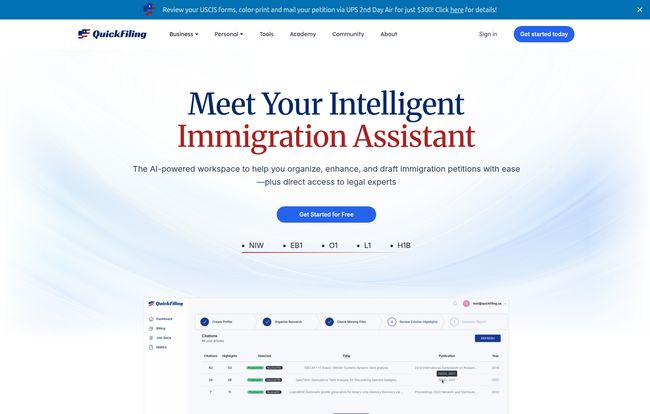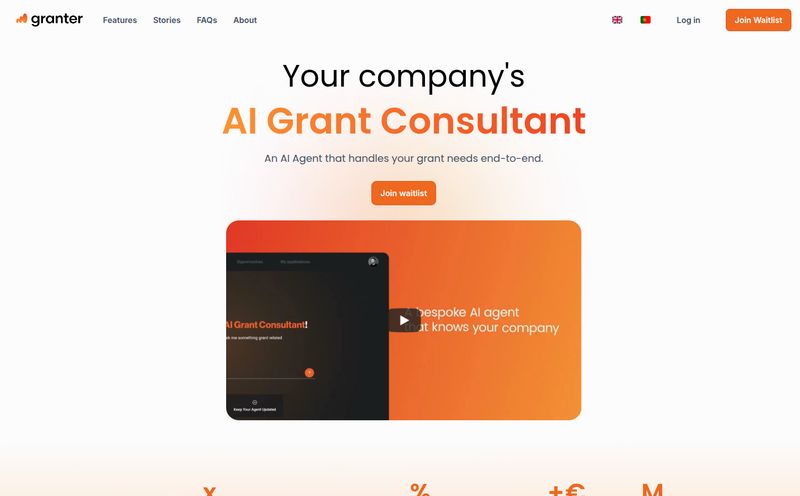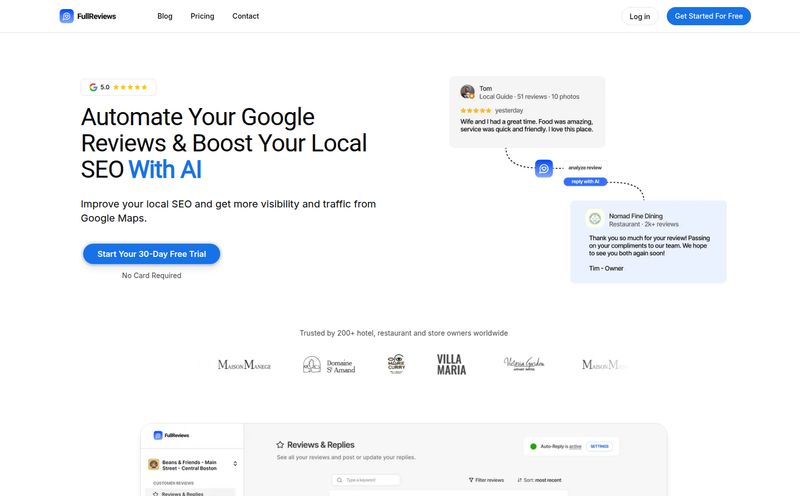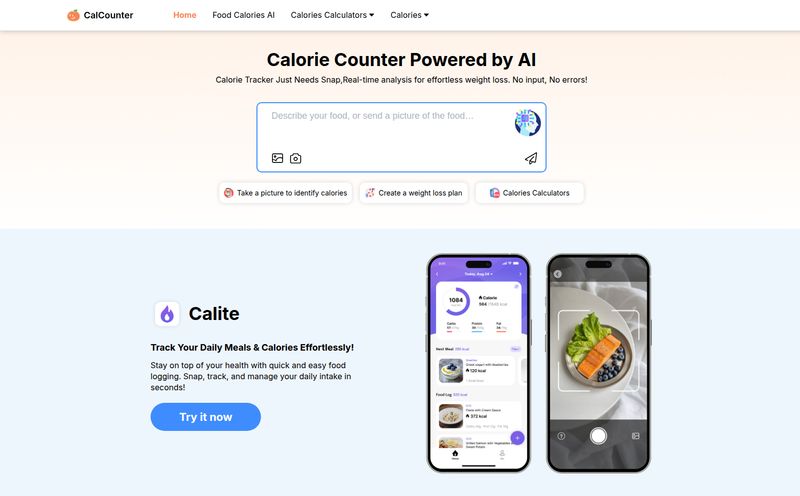The U.S. immigration process, especially for high-skilled visas like the EB-1, NIW, or O-1, can feel like trying to solve a Rubik's Cube... while blindfolded... on a rollercoaster. The paperwork is a mountain. The evidence required is immense. And the legal fees? They can make your eyes water.
For years, the only real options were to either pay a small fortune to a law firm or attempt the treacherous journey of a DIY application, armed with forums and a prayer. I’ve seen friends and colleagues go down both paths, and neither is exactly a walk in the park. It’s a high-stakes, high-stress game.
But what if there was a middle ground? What if technology could act as a sherpa for that mountain of paperwork? That's the promise of a platform I've been looking into called Quickfiling. It's an AI-powered workspace designed specifically for the grind of preparing immigration petitions. And I have to say, I'm intrigued.

Visit Quickfiling
So, What is Quickfiling, Really?
Think of Quickfiling less like a robot lawyer and more like a hyper-organized, incredibly efficient paralegal that works 24/7. It's a platform that gives you a suite of AI tools to help organize your evidence, draft your petition letters, and assemble the entire, monstrous package. It supports some of the most common—and complex—petitions: NIW (National Interest Waiver), EB-1 (Extraordinary Ability), O-1 (Extraordinary Ability/Achievement), H1B, and L-1.
Now, here's the most important thing to get straight from the jump: Quickfiling is not a law firm. They are very clear about this. They don't offer legal advice. Instead, they provide the tools and a structured workspace to do the heavy lifting of preparation yourself, or to collaborate with legal experts you can connect with through their platform. It’s a new model, and one that could seriously shake up the industry.
A Look Under the Hood at Quickfiling’s Features
This is where it gets interesting. It's not just a fancy document editor. The features are specifically built for the unique torture… I mean, process… of immigration petitions.
Evidence and Achievement Collection Made Simple
If you're applying for an NIW or EB-1 visa, you know that your entire case rests on proving your achievements. This usually means spending days, if not weeks, sifting through your entire career history, publications, citations, awards, and press mentions. It’s tedious work.
Quickfiling’s “Effortless Achievement Collection” feature is probably its crown jewel. The idea is that you feed it your documents—your CV, your papers, whatever you've got—and its AI gets to work extracting the key achievements. It does citation analysis, it can help rank your publications, and it organizes everything into a clean, usable format. This alone could save a shocking amount of time and prevent you from missing something important you forgot about from five years ago.
The AI-Powered Drafting Engine
Okay, so you've got your achievements. Now you have to write the actual petition letter and the dreaded Summary of Contributions (SoC). This is where you have to weave a compelling narrative for the USCIS officer. It's part legal argument, part storytelling.
Quickfiling has a tailored AI editor built for this. It takes your organized achievements and helps you draft these critical documents. It's not just a generic ChatGPT window; it's designed with the structure and language of immigration petitions in mind. This is a massive head start, though I’ll talk more later about why you can’t just blindly trust the AI.
The Recommendation Letter Builder
Ah, the recommendation letter. The awkward dance of asking esteemed professors or managers to write a glowing letter for you, and then likely having to draft it for them. It’s a weird, universally understood part of the process. Quickfiling includes a builder to streamline this, helping you or your recommenders craft powerful letters that hit all the right points USCIS looks for.
From Chaos to a Single PDF: Document Assembly
Once you have all your pieces—the letters, the forms, the exhibits, the table of contents—you have to assemble them. In the right order. With the right formatting. It’s a final, frustrating hurdle. The platform’s “One-Stop Document Assembly” takes all the components you've worked on within Quickfiling and compiles them into a single, organized, ready-to-file PDF. It even has a “Smart Form” feature that helps pre-fill those repetitive USCIS forms. A small thing, but oh-so-satisfying.
DIY vs. Done-For-You: You Get to Choose Your Path
I really like the flexibility offered here. It’s not an all-or-nothing system. You can pick your level of involvement based on your budget and confidence.
- Pure DIY: You can use the tools to draft your SoC or the entire petition on your own. This is the most cost-effective route, for sure.
- Guided DIY: You're still in the driver's seat, but you have access to their guides, tutorials, and a more structured process to get it done in days, not months.
- A La Carte Services: This is a great middle ground. You can get an expert to review your self-prepared petition or help you respond to a dreaded Request for Evidence (RFE).
- Full-Service Filing: If you decide you want a professional to take over, they can connect you with their legal partners who will handle the entire case from start to finish.
This tiered approach feels very modern and customer-centric. It acknowledges that not everyone needs or can afford a full-service lawyer from day one.
The Good, The Bad, and The AI
No tool is perfect. As a professional who lives and breathes digital tools, I'm always looking for the catch. Here’s my honest breakdown of Quickfiling.
The Good Stuff. The time and money savings are the most obvious benefits. The potential to cut down preparation time from months to weeks, or even days, is huge. The AI-powered evidence mining is a genuine game-changer for anyone with a deep research or project history. And having access to legal experts on-demand provides a safety net that pure DIY methods lack. It democratizes access to high-quality preparation tools that were previously only available within law firms.
The Caveats. The biggest thing to remember, and I’ll say it again, is that it's not a law firm. You are ultimately responsible for your petition. The second point is the reliance on AI. AI is a fantastic assistant, but it’s not infallible. You absolutely MUST review, edit, and personalize the drafts it creates. Think of the AI as generating a B+ first draft; it's your job to use your own brain and unique context to turn it into an A+. Finally, while the DIY tools are meant to be affordable, the full-service options through their partners will naturally be more expensive. That's just the reality of paying for expert time.
So, How Much Does Quickfiling Cost?
This is the million-dollar question, isn't it? As of my review, Quickfiling doesn't have a public pricing page. This is pretty common for specialized platforms like this. The cost likely varies significantly based on which visa you're applying for and which level of service you choose—from the basic DIY tools to a full-service package.
My guess is that you'll need to sign up or contact them directly to get a quote tailored to your specific situation. While I always prefer transparent pricing, this approach does make sense for a service this customized.
Who Is This Really For?
I see Quickfiling being a fantastic fit for a few types of people:
- The Organized Professional: Researchers, engineers, artists, or entrepreneurs who are confident in their case but just need help with the monumental task of organizing and drafting.
- The Budget-Conscious Applicant: Someone who can't stomach a five-figure legal bill but is willing to put in the work to save a significant amount of money.
- The 'Hybrid' Applicant: Someone who wants to prepare the bulk of the petition themselves but wants the peace of mind of having an expert review it before filing.
If you're looking for someone to just take the problem off your hands entirely with zero effort on your part, you might be better off going straight to a traditional law firm. But if you're willing to be an active participant in your own case, this could be the perfect co-pilot.
My Final Take on Quickfiling
I'm genuinely impressed. The immigration process has been stuck in the dark ages for a long time, and it's about time technology stepped in to provide a smarter way forward. Quickfiling appears to be a powerful, well-designed platform that addresses the real pain points of petition preparation.
It’s not a magic button that will grant you a visa. You still need a strong case, and you still need to use your own judgment. But it is a powerful assistant that can handle the most grueling, time-consuming parts of the process, freeing you up to focus on strategy and telling your best story. For the right person, this tool could be the difference between a stressful, months-long ordeal and a streamlined, manageable project. And that, in my book, is a massive win.
Frequently Asked Questions
- Is Quickfiling a law firm? Can it give me legal advice?
- No, Quickfiling is a technology platform, not a law firm, and it cannot provide legal advice. It provides AI-powered tools for petition preparation. However, it can connect users with legal experts and law firms for personalized guidance or full representation if needed.
- What types of U.S. visas does Quickfiling support?
- Quickfiling is designed to assist with several high-skilled employment-based visas, including NIW (National Interest Waiver), EB-1 (Extraordinary Ability), O-1 (Extraordinary Ability/Achievement), H1B (Specialty Occupation), and L-1 (Intracompany Transferee).
- Can I use Quickfiling if I am applying from outside the United States?
- Yes. The platform is accessible from anywhere. They even offer services to help with challenges that applicants abroad might face, such as making U.S. dollar payments for filing fees.
- Is the content generated by the AI ready to be filed immediately?
- No. The AI provides a very strong first draft based on the information you provide. It is crucial that you review, edit, and personalize all AI-generated content to ensure it is 100% accurate and best reflects your unique profile and achievements before filing.
- How does the 'Effortless Achievement Collection' feature work?
- This feature uses AI to scan documents you upload, such as your CV or research papers. It then identifies and extracts key data points like publications, citations, awards, and other achievements, organizing them for easy inclusion in your petition.
- What if I need help after I file and get a Request for Evidence (RFE)?
- Quickfiling offers services specifically for this situation. You can engage one of their partnered legal experts to help you prepare and file a strong response to an RFE, even if you prepared the initial petition on your own.
References and Sources
- Quickfiling Official Website: https://quickfiling.com/



